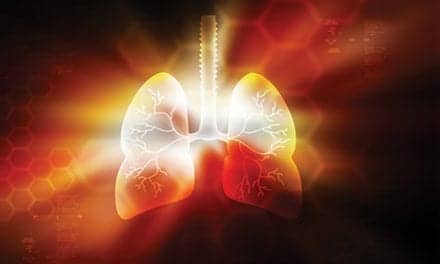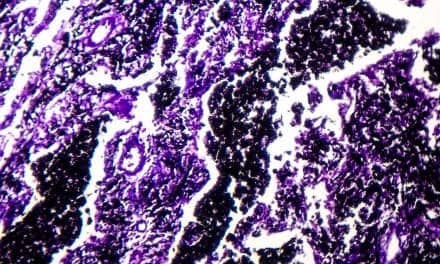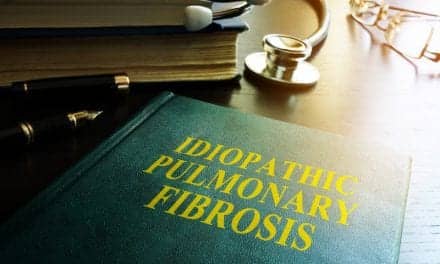By Brendan Lillie, BS, RRT-NPS

Background
In 1938, Andersen and colleagues first described infants with gastrointestinal obstruction or malnutrition and overwhelming respiratory infections as having “cystic fibrosis of the pancreas.”3 These patients usually died during the first year of life. Postmortem studies of these patients revealed obstruction of the pancreatic ducts, airways, and intestinal tract with exceedingly viscous mucus.3 In the 1950s, Di Sant’Agnese and colleagues made the discovery of high levels of salt in the sweat of CF patients.3
In 1989, genetic research discovered the gene accountable for CF. Known as the cystic fibrosis transmembrane conductance regulator gene, or CFTR, it is located on human chromosome 7, and is mutated in individuals with CF.1,2 CFTR is part of a family of proteins that serve as chloride channel pumps.3 These proteins are located on the surface of epithelial cells that line the lungs, airways, pancreas, gastrointestinal and reproductive tracts, and sweat ducts.3 The CFTR gene mutation affects the cellular channels that transport negatively charged chloride ions into and out of cells, thereby disrupting the fluid balance in the body’s tissues.2 This ultimately leads to a buildup of thick, viscous secretions in the lungs, which can result in severe respiratory distress if secretions are not mobilized and removed from the airways.
Current Treatments
Secretion Clearance. The treatment of CF lung disease focuses on diligent airway clearance techniques, which will help prevent the long-term deterioration of lung function. Therapies also need to focus on the treatment of acute primary exacerbations.3 Airway clearance modalities have started to lean away from traditional chest physical therapy, and several external devices are used to help mobilize secretions. Patients are given instruction on the proper use of devices such as the Acapella (Smiths Medical), Vest (Hill-Rom), and other forms of positive expiratory pressure (PEP) therapy. These devices aid in the clearance of mucous plugs, prevent atelectasis, and maintain lung function. Autogenic drainage and exercise also are taught and encouraged. Increases in exercise can lead to significant improvement in lung function and lessen dyspnea in CF patients.5
Aerosol Therapies. There are several inhaled medications that aid in the treatment of CF. One group of inhaled medications used is bronchodilators. Beta-agonist and anticholinergic medications aid in mucous clearance by dilating the airways. These medications also help prevent bronchospasm that may be induced by other inhaled medications used to treat CF.3
Inhaled hypertonic saline can be used to treat CF. It can be given in concentrations of 3% or 7%, depending on how aggressive the physician wants to be with treatment. Isotonic saline (“normal saline”) has a concentration of 0.9%, so by increasing the salt concentration, there is a possibility of drawing fluid out of the cells lining the airways by changing the osmolality of secretions, thereby making secretions less viscous and easier to clear.
Inhaled antibiotics also are used to treat CF. Tobramycin can be given to help fight Pseudomonas aeruginosa, a bacteria commonly found in the lungs of CF patients. P. aeruginosa is associated with higher mortality rates and accelerated worsening of long-term CF.8 Another inhaled antibiotic used to treat CF is aztreonam lysine (Cayston). This medication is a monobactam antibiotic and is effective in treating many gram-negative bacteria.9
New CF Medications
One of the newest medications being used to treat CF is Kalydeco, or ivacaftor (Vertex Pharmaceuticals, Cambridge, Mass). In January 2012, the FDA approved Kalydeco for the treatment of CF patients with the G551D mutation of the CFTR gene.6 This mutation represents about 4% of all CF patients, and is classified as a cystic fibrosis transmembrane conductance regulator potentiator. It works by facilitating the chloride transport into and out of cells by opening the CFTR chloride channel.4
Jeffrey Riker, MD, physician director of the Adult Cystic Fibrosis Program at Long Beach Memorial Medical Center, Long Beach, Calif, has been treating patients with ivacaftor. He has seen some promising results. Patients have had a decrease in sputum production, gained weight, and had their sweat chloride test results improve to normal. They also had an improvement in the mean FEV1 of 10% of predicted compared to patients given placebo. One of his patients had presented with severe respiratory failure and had an FEV1 of 21% of predicted value. After starting ivacaftor, his FEV1 improved to 40% of predicted, he no longer required supplemental oxygen, and he has noticed a decrease in the need for pancreatic enzyme therapy. Jeremy Johnson, CFTR specialist at the Cystic Fibrosis Center at Long Beach Memorial, says they have seen “absolutely amazing results” with the patients who are taking ivacaftor.
Long Beach Memorial also participated in the PTC-124 drug trial. This medication has different pharmacokinetic properties and benefits than does ivacaftor. Riker’s personal experience with the trial seems to indicate “not as dramatic results” as compared with ivacaftor, but further research is needed.
Riker’s facility will be a trial site in a multicenter study of ivacaftor and VX-809 in patients homozygous for the Delta F508 gene mutation. This group represented 80% of all CF patients. The goal of VX-809 is to move the defective CFTR protein to its correct location at the cell surface, whereas ivacaftor’s primary goal was to improve the function of defective CFTR chloride gathering at the cell surface.6,7
New Antibiotics
There are several new forms of aerosol antibiotics being developed for the treatment of CF. Developers are focusing on different classes of antibiotics in hopes of treating a wider spectrum of bacteria. These classes include polymyxins, aminoglycosides, and fluoroquinolones.9
Polymyxins. Studies in Europe using dry power colistimethate sodium have been conducted and researchers have received authorization to conduct further studies.9
Aminoglycosides. PulmoSphere (Inhalation Therapeutic Systems) uses a dry powder inhaler to administer tobramycin. This tobramycin inhalation powder, or TIP, appears to be more effective than nebulized tobramycin.9 Another liposomal formulation in development, amikacin, has been shown to penetrate biofilms in vitro.9 Furthermore, P. aeruginosa secretes certain virulence factors that facilitate the release of amikacin from liposomes. This targets the drug at the bacterial microenvironment.9
Fluoroquinolones. Used for years to fight gram-positive and gram-negative bacteria, fluoroquinolones are traditionally administered via the oral or IV route. There are now two versions of inhaled levofloxacin being developed.9 One of the formulations uses the same dry powder technology as TIP, while the other consists of a liposomal formulation and is administered via a jet nebulizer.9
Respiratory Failure in CF Patients
The inability to clear the airways of thick, viscous secretions can lead to impaired gas exchange, thereby causing a V/Q mismatch. If this cannot be corrected, then supplemental oxygen therapy may be needed.
In the late stages of CF, the majority of deaths occur due to hypercapnic and/or hypoxemic respiratory failure.3 The patient’s lung function can become so impaired that normal gas exchange cannot be achieved. This can lead to the need for noninvasive ventilatory support, intubation and mechanical ventilation, or even lung transplantation.
The use of noninvasive positive pressure ventilation (NPPV) can assist in the removal of excess carbon dioxide in the blood due to increased dead space ventilation. Some patients may avoid endotracheal intubation and its associated morbidity by the use of NPPV.11 NPPV also can reduce muscle fatigue, thereby decreasing the oxygen consumption of the respiratory muscles.
If NPPV is not effective, endotracheal intubation and mechanical ventilation may be the next step in fighting CF. Depending on the patient and the severity of lung disease, some CF patients may not survive, even with the assistance of the ventilator. This is when the discussion of lung transplantation occurs.
Lung transplantation is generally accepted as a useful modality of care for patients with severe, life-threatening respiratory diseases that are refractory to conventional therapies.12 Lung transplantation does not come without risk, if a matching donor is even found. There are several guidelines in pretransplant CF patients that may indicate an increased mortality rate and therefore need to be considered for all transplants. Those guidelines include an FEV1 of less than 30% predicted value, and elevated PaCO2, and low PaO2 value on arterial blood gas analysis.12 Transplantation can prove extremely effective in CF patients because there has been no evidence of redevelopment of CF in the transplanted lungs.10 The danger for lung transplant CF patients comes from organ rejection and opportunistic infection due to the immunosuppressive agents that must be taken.
Looking Ahead
In the future, treatment of cystic fibrosis will start near birth. Some studies have shown that screening infants for cystic fibrosis can lead to significantly less pulmonary disease and stable lung function with less marked decline over time.13 One study in London found that even though infants were diagnosed early with CF with a newborn screen and given protocol-driven treatment, they still developed abnormal lung function, with increased nonuniform ventilation and hyperinflation and diminished airway function by 3 months of age.13
Jeffrey Riker has similar views. His ideal conditions for the future treatment of CF start with genetic testing at birth and beginning CFTR repair treatment early in life. He hopes that there will be some sort of genetic correcting medication and that these patients may never even develop cystic fibrosis.
All current CF treatment methods are considered effective and should continue to be implemented. With the discovery of new medications, the effectiveness of these current methods may be enhanced and disease progression delayed. This will hopefully lead to an improved quality of life for people living with cystic fibrosis. RT
Brendan Lillie, BS, RRT-NPS, is a staff respiratory therapist at Newton-Wellesley Hospital in Newton, Mass. For further information, contact [email protected].
References
1. Cystic Fibrosis Research Inc (CFRI). http://www.cfri.org/cf.shtml
2. Genetics Home Reference. http://ghr.nlm.nih.gov/conditions/cystic-fibrosis
3. Hess D, Macintyre NR, Mishoe SC, et al. Respiratory Care Principles and Practice. Philadelphia: WB Saunders Co; 2002:1003-1017.
4. U.S. Food and Drug Administration. http://www.accessdata.fda.gov/drugsatfda_docs/2012/2031881bl.pdf
5. Paranjape SM, Barnes LA, Carson KA, et al. Exercise improves lung function and habitual activity in children with cystic fibrosis. J Cyst Fibros. 2012;11:18-23.
6. CFRInews. Approval of Kalydeco Bodes Well for New CF Drugs Targeting Genetic Defects. Spring 2012.
7. The Cystic Fibrosis Foundation. http://cff.org/research/ClinicalResearch/FAQs/CombinedKalydeco-VX809/
8. Buyck JM, Verriere V, Benmahdi R, et al. P. aeruginosa LPS stimulates calcium signaling and chloride secretion via CFTR in human bronchial epithelial cells. J Cyst Fibros. 2013;12:60-67.
9. Ballmann M, Smyth A, Geller DE. Therapeutic approaches to chronic cystic fibrosis respiratory infections with available, emerging aerosolized antibiotics. Respir Med. 2011;105(Suppl 2):S2-S8.
10. Walsh B, Czervinske M, DiBlasi R. Perinatal and Pediatric Respiratory Care. 3rd ed. Philadelphia: Saunders; 2010:599-610.
11. Hess D, Kacmarek RM. Essentials of Mechanical Ventilation. New York: McGraw-Hill; 2002:153.
12. Glanville AR, Estenne M. Indications, patient selection and timing of referral for lung transplantation. Eur Respir J. 2003;22:845-852.
13. Hoo A, Thia LP, Nguyen TT, et al. Lung function is abnormal in 3-month-old infants with cystic fibrosis diagnosed by newborn screening. Thorax. 2012;67:874-881.










